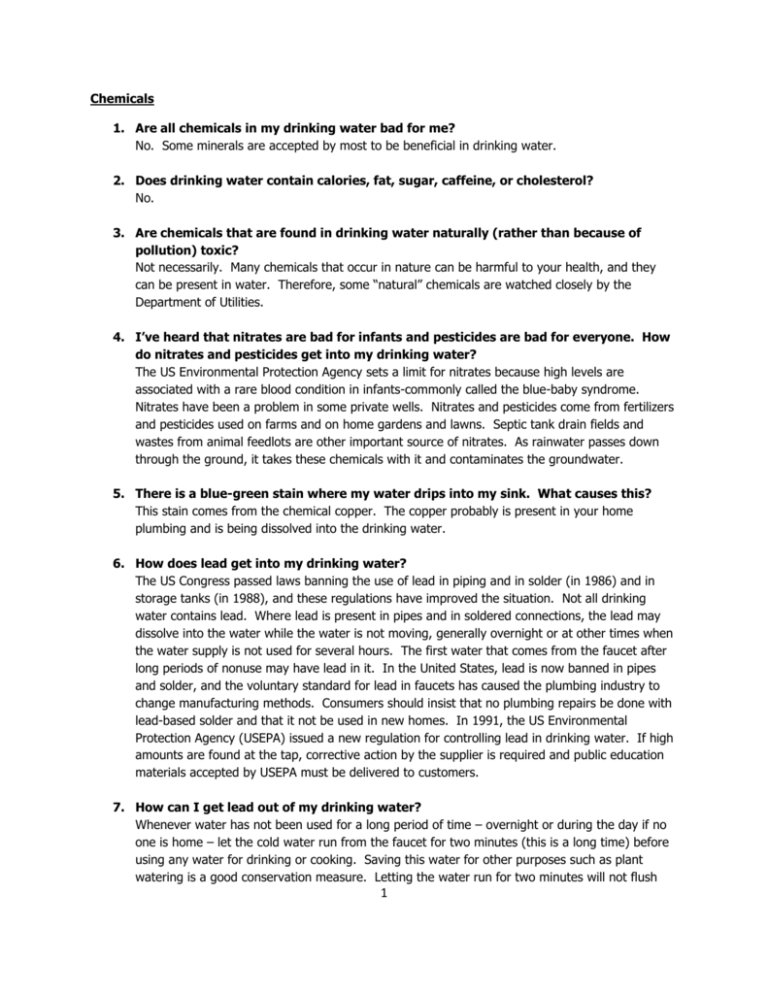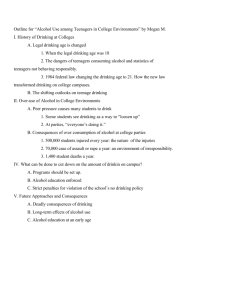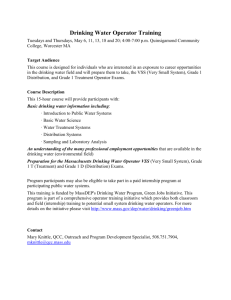Chemicals 1. Are all chemicals in my drinking water bad for me? No
advertisement

Chemicals 1. Are all chemicals in my drinking water bad for me? No. Some minerals are accepted by most to be beneficial in drinking water. 2. Does drinking water contain calories, fat, sugar, caffeine, or cholesterol? No. 3. Are chemicals that are found in drinking water naturally (rather than because of pollution) toxic? Not necessarily. Many chemicals that occur in nature can be harmful to your health, and they can be present in water. Therefore, some “natural” chemicals are watched closely by the Department of Utilities. 4. I’ve heard that nitrates are bad for infants and pesticides are bad for everyone. How do nitrates and pesticides get into my drinking water? The US Environmental Protection Agency sets a limit for nitrates because high levels are associated with a rare blood condition in infants-commonly called the blue-baby syndrome. Nitrates have been a problem in some private wells. Nitrates and pesticides come from fertilizers and pesticides used on farms and on home gardens and lawns. Septic tank drain fields and wastes from animal feedlots are other important source of nitrates. As rainwater passes down through the ground, it takes these chemicals with it and contaminates the groundwater. 5. There is a blue-green stain where my water drips into my sink. What causes this? This stain comes from the chemical copper. The copper probably is present in your home plumbing and is being dissolved into the drinking water. 6. How does lead get into my drinking water? The US Congress passed laws banning the use of lead in piping and in solder (in 1986) and in storage tanks (in 1988), and these regulations have improved the situation. Not all drinking water contains lead. Where lead is present in pipes and in soldered connections, the lead may dissolve into the water while the water is not moving, generally overnight or at other times when the water supply is not used for several hours. The first water that comes from the faucet after long periods of nonuse may have lead in it. In the United States, lead is now banned in pipes and solder, and the voluntary standard for lead in faucets has caused the plumbing industry to change manufacturing methods. Consumers should insist that no plumbing repairs be done with lead-based solder and that it not be used in new homes. In 1991, the US Environmental Protection Agency (USEPA) issued a new regulation for controlling lead in drinking water. If high amounts are found at the tap, corrective action by the supplier is required and public education materials accepted by USEPA must be delivered to customers. 7. How can I get lead out of my drinking water? Whenever water has not been used for a long period of time – overnight or during the day if no one is home – let the cold water run from the faucet for two minutes (this is a long time) before using any water for drinking or cooking. Saving this water for other purposes such as plant watering is a good conservation measure. Letting the water run for two minutes will not flush 1 out all of the lead that got into the water while it was sitting in your plumbing, but it will improve the situation greatly. Some home treatment equipment (sometimes called lead removing filter, reverse osmosis [RO] systems, and distillation units) removes lead dissolved in water, but unfortunately, manufacturer’s claims are not always accurate, so be cautious and check with independent organizations. 8. Is it safe to drink water from a drinking fountain? Yes, usually. Some older, floor-standing water coolers contain lead-lined storage tanks, and there is a possibility that high amounts of lead could get into the water in these tanks. The US Congress passed laws banning the use of lead in piping and in solder (in 1986) and in storage tanks (in 1988), and these regulations have improved the situation. One section of the 1998 regulations encourages schools and day-care centers to test their fountains for lead. Letting the water run for a while before drinking from a drinking fountain minimizes the risk. 9. Is the fluoride in my drinking water safe? Yes. When added or naturally present in the correct amounts, fluoride in drinking water has greatly improved the dental health of American consumers. A 1993 report by the National Research Council of the National Academy of Sciences, Health Risk of Ingested Fluoride, states, “Currently allowed fluoride levels in drinking water do not pose a risk of health problems such as cancer, kidney failure, or bone disease.” 10. Will I loose the benefits of fluoride in my drinking water if I install a home treatment device or drink bottled water? Certain types of home treatment devices will remove 85 to more than 95 percent of all minerals in water, including fluoride. The situation with bottled water is less clear. If you are drinking bottled water, most likely you are not getting much fluoride. 11. Is water with chlorine in it safe to drink? Yes. Many tests have shown that the amount of chlorine found in treated water is safe to drink, although some people object to the taste. 12. Should I be concerned about the chlorine in the water I use for bathing or showering? No, for two reasons: (1) it will not be absorbed into the skin and get into your body; and (2) the amount of chlorine in water is too low to harm the skin itself. If you have any trouble in swimming pools, remember that the amount of chlorine in swimming pool water is much greater than in tap water. 13. I hear aluminum is used to treat drinking water. Is this a problem? Does it cause Alzheimer’s disease? Aluminum-containing chemicals – called alum (AL*um) or aluminum sulfate – are used to treat most surface waters. These chemicals trap dirt and then form large particles in the water that settle out; thus, very little aluminum stays in the water. Considerable publicity was given to some studies suggesting that more people got Alzheimer’s disease in areas where drinking water 2 contained small amounts of aluminum. According to most Alzheimer’s disease experts, these reports are not accurate. 14. What is radon and is it harmful in drinking water? Radon is a radioactive gas that is dissolved in some groundwater. It is formed with radium or uranium decays naturally. According to the amendment to the Safe Drinking Water Act passed in 1996, the US Environmental Protection Agency will set standards for radon early in the next century, and treatment methods are already available for use by water suppliers if radon removal is required. More radon in air comes from the ground than from drinking water. 15. I’m worried that my drinking water has radon in it and that the radon will get into the air in my home. How can I test the air in my home for radon? Telephone your local health department to find out if it knows whether your drinking water contains radon or if radon is a problem in your area. If you decide that your home should be tested, you can purchase a testing device. Two types of devices are available from hardware and similar stores for prices ranging from $10 to $30. Both contain prepaid mailing envelopes for sending the detector to a laboratory for testing. The test results then are sent back to you. Radon gas seeping into a home from underground is a major source of radon in indoor air. Consequently, either type of testing device should be placed in the basement or on the first floor (if your home has no basement) where radon concentrations are likely to be highest. 16. Will a water softener take radon and radium out of my water? Radon, no. Radium, yes. Water softeners are very effective in removing radium, but they do not remove radon. Remember that radium is a radioactive element that occurs naturally in some soils and thus in some groundwaters, along with radon. 3







